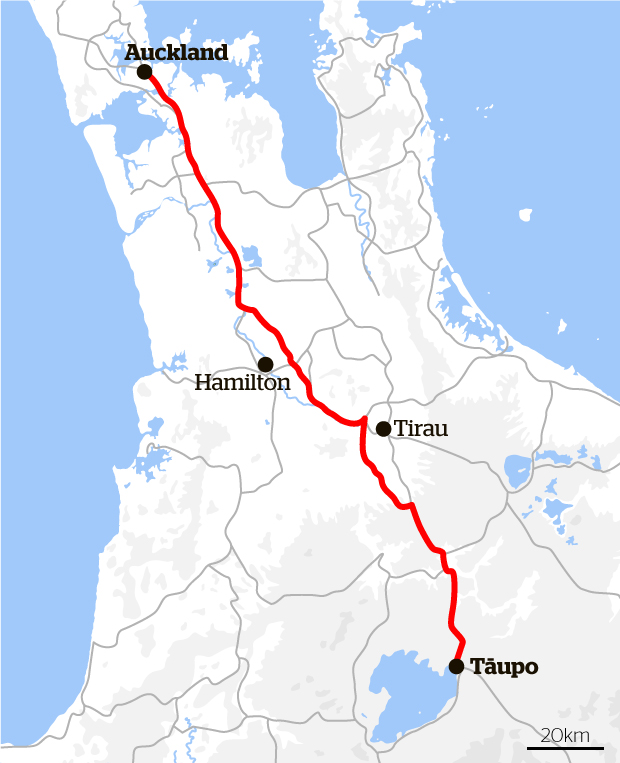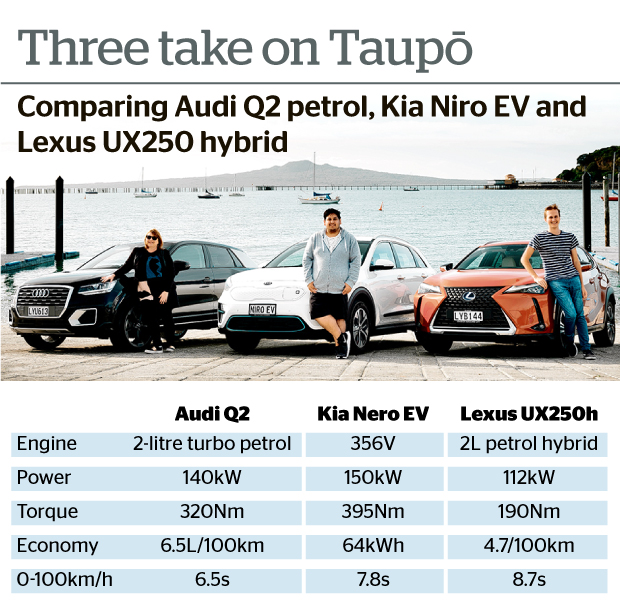If roads could talk, the ribbon of bitumen separating Auckland and Taupō would tell some corking stories.
Few stretches of motorway see more traffic. This is, to my mind, the most commonly plotted Kiwi road trip. Far away enough for those sick of the big smoke to feel like they're on foreign land, yet close enough to be knocked off between lunch and dinner.
In other words, it was the perfect backdrop for posing what on the face of it seems a fairly regulation question; has the electric car advanced enough yet to take on the traditional out-of-town roadie?

To try and get to the bottom of the conundrum, Driven arranged three same-but-different vehicles with three different kinds of drivetrains from the same segment; the petrol Audi Q2, hybrid Lexus UX250h, and fully electric Kia Niro EV.
The 2-litre TSFI Sport S-tronic Audi will set you back $64,900, just a handful of dollars less than the also 2-litre Lexus — which starts at $65,900. While the Audi and Lexus clearly attack the problem from different angles, the Kia is a significant outlier in the group from the outset.
For starters, it's more expensive. Prices start at $69,990 for the 39.2kWh battery, 100kW entry trim but our long-range 64kWh battery, 150kW EX 455 model is priced from $73,990.
It also looks significantly different. The Audi and Lexus are more sculpted and stylish in their form, while the Kia adopts a more traditional look. It works, too — the longer wheelbase and boxier stance contributing to a much roomier second row of seats and a bigger boot (451L versus the Audi's 405L and the Lexus' 401L).
Our journey started at NZME HQ, with a brief fight over keys leaving me with the Kia while Editor at Large Liz Dobson took the Audi and fresh recruit Andrew Sluys took control of the Lexus.
The drive down was to deviate slightly from the standard Taupō roadie. Naturally we'd bypass Hamilton, before turning off SH1 at Piarere for a winding, twisty detour bisecting the wide open expanses of Arapuni — eventually rejoining SH1 in Tokoroa.
A solid plan, thwarted.

Expecting the unexpected is the norm for the Kiwi road trip, and during our twisty diversion this came in the form of an upturned semi truck, parked abruptly on its side in the middle of nowhere and being tended to by a crane and police.
The subsequent detour-of-a-detour extended the trip down to the detriment of the Kia. Our long-range model has a 455km range according to WLTP data, but in the real world that numbers have to be taken with a grain of salt. Particularly in places like New Zealand, where roads are so frequently shaped by the land and when rain (efficient driving's kryptonite) is so common — as it was on our trip.
We did make it to Taupō, but not without minor stresses over the Kia's range. What was eventually an approximate 300km drive had burned up 369km worth of energy from the Niro's 64kWh battery.

Having swapped to the Lexus for the final phase of driving to our destination it became apparent that Liz, now in the Kia, was probably suffering from range anxiety. Normally something of a lead-footed demon, she instead sat back in traffic — later clarifying that she was in full preservation mode.
“I turned on the Nero’s heater, and that immediately took 40km off my battery range,” she laughed over lunch. “Off went the heater … instead I had to take turns sitting on a hand to keep warm.”
'Preservation mode', in this case, entailed making the most of the Niro's 'single pedal' driving. Ramp up the Korean EV's regenerative braking to its maximum, and almost all driving can be done with the throttle pedal alone. The Niro can slow you down to about 10km/h, leaving that last little bit for you.

This, coupled with plenty of momentum driving down hills and to stop signs, helped Liz regenerate some of the mileage that had been lost in our apparently flagrant earlier driving. But, it raised the new concern of where to charge it for the journey back. The 55km of range indicated on the odometer wouldn't be remotely enough.
While we mulled over charging the Kia (the two EV charging spots at the local Warehouse had, inexplicably, been filled by a pair of oblivious petrol cars), we discussed the Audi and Lexus' merits.
The Audi's handling was a clear step or two ahead of the other two. Through the winding roads it visually looked more composed and controlled — body roll kept at ease by adaptive sports suspension and Quattro all-wheel drive.

Andrew noted its stiffness compared to the other two (“switching to comfort mode made things a little softer, but the car’s sporty undertones were still quite obvious”), but then reverted back to making oversteer gestures with flailing arms. The “peppy” 2-litre turbocharged petrol had its fans, too. In this company it was clearly the most characterful and engaging powertrain.
We all came to a sharp agreement that the Lexus lost huge points for its infotainment system. The touch-pad interface is one that none of us are particularly used to, even after having driven a swag of Lexus models in the past.
But even so, I identified the little UX as being my preferred place to sit. Naff infotainment or not, it was the most plush of the trio.
We were split over the Q2's cabin. Liz and Andrew praised its simplicity ("there’s no guessing, and everything does exactly what you think it does") to my eye it was the number one element that earmarked the Q2 as 'one of the cheap Audis'.
The heavily stylised Lexus interior, on the other hand, is nice enough and convincing enough to be easily mistaken for almost anything else in the Japanese car-maker's line-up.

Liz ended up siding with the sporty Audi, and Andrew with the Lexus — particularly off the back of its impressive economy. By the end of the day we had matched its claimed 4.7L/100km figure.
"Once you get your head around the touch pad that controls the infotainment system, the car as a whole makes a lot more sense," he added. "The engine doesn’t feel as responsive as the Audi’s turbo lump, or the Kia’s electric motor, but has the power to pass when needed."
Part of me wanted to lean with the Lexus too, especially after we came back from lunch to realise that the charger we had plugged the Niro into was little more than a glorified toaster. In the hour or so it had been plugged in, range had only increased to 80km.
Some of the blame laid out our feet, of course. Much due diligence is required for long journeys with this cars, with particular attention required for knowing how good quick each charger on the journey will be. The Niro, for what it's worth, takes 75 minutes to charge from empty to 80 per cent when plugged into a fast-charger.

But, with Liz and Andrew doing the honourable thing and leaving me to charge for the drive home (just over $20 of juice at a ChargeNet CHAdeMo plug got me home in the end), I still ended up completing the triangle and siding with the Niro.
Just a few years ago you had to spend six figures to get an EV with similar range. Road trips might require a bit more planning, but your passengers will be thankful for the extra space. It's one of the most complete EVs on the market.
And if you're still not sure about the whole electric thing, there's a hybrid one, too.
















